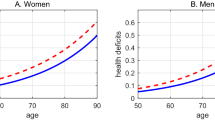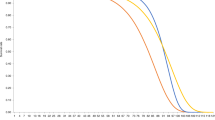Abstract
Increasing life expectancy has been interpreted as improving health of a population. However, mortality is not always a reliable proxy for the pace of aging and could instead reflect achievement in keeping ailing people alive. Using data from NHANES III (1988–1994) and NHANES IV (2007–2010), we examined how biological age, relative to chronological age, changed in the United States between 1988 and 2010, while estimating the contribution of changes in modifiable health behaviors. Results suggest that biological age is lower for more recent periods; however, the degree of improvement varied across age and sex groups. Overall, older adults experienced the greatest improvement or decreases in biological age. Males, especially those in the youngest and oldest groups, experienced greater declines in biological age than females. These differences were partially explained by age- and sex-specific changes in behaviors, such as smoking, obesity, and medication use. Slowing the pace of aging, along with increasing life expectancy, has important social and economic implications; thus, identifying modifiable risk factors that contribute to cohort differences in health and aging is essential.





Similar content being viewed by others
References
Belsky, D. W., Caspi, A., Houts, R., Cohen, H. J., Corcoran, D. L., Danese, A., . . . Moffitt, T. E. (2015). Quantification of biological aging in young adults. Proceedings of the National Academy of Sciences, 112, E4104–4110.
Butler, R. N., Sprott, R., Warner, H., Bland, J., Feuers, R., Forster, M., . . . Wolf, N. (2004). Biomarkers of aging: From primitive organisms to humans. Journals of Gerontology, Series A: Biological Sciences and Medical Sciences, 59, 560–567.
Cho, I. H., Park, K. S., & Lim, C. J. (2010). An empirical comparative study on biological age estimation algorithms with an application of Work Ability Index (WAI). Mechanisms of Ageing and Development, 131, 69–78.
Cohen, J. D., Cziraky, M. J., Cai, Q., Wallace, A., Wasser, T., Crouse, J. R., & Jacobson, T. A. (2010). 30-year trends in serum lipids among United States adults: Results from the National Health and Nutrition Examination Surveys II, III, and 1999–2006. American Journal of Cardiology, 106, 969–975.
Comfort, A. (1969). Test-battery to measure ageing-rate in man. Lancet, 294, 1411–1415.
Crimmins, E. M., & Beltran-Sanchez, H. (2011). Mortality and morbidity trends: Is there compression of morbidity? Journals of Gerontology, Series B: Psychological Sciences and Social Sciences, 66, 75–86.
Crimmins, E. M., & Finch, C. E. (2006). Infection, inflammation, height, and longevity. Proceedings of the National Academy of Sciences, 103, 498–503.
Daviglus, M. L., Liu, K., Yan, L. L., Pirzada, A., Manheim, L., Manning, W., . . . Stamler, J. (2004). Relation of body mass index in young adulthood and middle age to Medicare expenditures in older age. JAMA, 292, 2743–2749.
Fee, E. (1991). Save the babies: American public health reform and the prevention of infant mortality, 1850–1929. Medical History, 35, 374–375.
Finch, C. E., & Crimmins, E. M. (2004). Inflammatory exposure and historical changes in human life-spans. Science, 305, 1736–1739.
Finch, C. E., & Kirkwood, T. B. L. (2000). Chance, development, and aging. New York, NY: Oxford University Press.
Finucane, M. M., Stevens, G. A., Cowan, M. J., Danaei, G., Lin, J. K., Paciorek, C. J., . . . Ezzati, M. (2011). National, regional, and global trends in body-mass index since 1980: Systematic analysis of health examination surveys and epidemiological studies with 960 country-years and 9.1 million participants. Lancet, 377, 557–567.
Fries, J. F. (1983). The compression of morbidity. Milbank Memorial Fund Quarterly: Health and Society, 61, 397–419.
Goetzel, R. Z. (2009). Do prevention or treatment services save money? The wrong debate. Health Affairs, 28, 37–41.
Hajjar, I., & Kotchen, T. A. (2003). Trends in prevalence, awareness, treatment, and control of hypertension in the United States, 1988–2000. JAMA, 290, 199–206.
Hayward, M. D., & Gorman, B. K. (2004). The long arm of childhood: The influence of early-life social conditions on men’s mortality. Demography, 41, 87–107.
Heckman, J. J. (2006). Skill formation and the economics of investing in disadvantaged children. Science, 312, 1900–1902.
Kirkwood, T. B. (2002). Evolution of ageing. Mechanisms of Ageing and Development, 123, 737–745.
Klemera, P., & Doubal, S. (2006). A new approach to the concept and computation of biological age. Mechanisms of Ageing and Development, 127, 240–248.
Levine, M. E. (2013). Modeling the rate of senescence: Can estimated biological age predict mortality more accurately than chronological age? Journals of Gerontology, Series A: Biological Sciences and Medical Sciences, 68, 667–674.
Levine, M. E., & Crimmins, E. M. (2014a). A comparison of methods for assessing mortality risk. American Journal of Human Biology, 26, 768–776.
Levine, M. E., & Crimmins, E. M. (2014b). Evidence of accelerated aging among African Americans and its implications for mortality. Social Science & Medicine, 118, 27–32.
Mooradian, A. D. (1990). Biomarkers of aging: Do we know what to look for? Journal of Gerontology, 45, B183–B186.
National Center for Health Statistics (NCHS). (2011). Health, United States, 2010: With special feature on death and dying. Hyattsville, MD: NCHS.
National Research Council. (2011). Explaining divergent levels of longevity in high-income countries. (E. M. Crimmins, S. H. Preston, & B. D. Cohen, Eds.).Washington, DC: National Academies Press.
Oeppen, J., & Vaupel, J. W. (2002). Demography—Broken limits to life expectancy. Science, 296, 1029–1031.
Phoenix, C., & de Grey, A. D. N. J. (2007). A model of aging as accumulated damage matches observed mortality patterns and predicts the life-extending effects of prospective interventions. Age, 29, 133–189.
Preston, S. H., & Wang, H. D. (2006). Sex mortality differences in the United States: The role of cohort smoking patterns. Demography, 43, 631–646.
Psaty, B. M., Manolio, T. A., Smith, N. L., Heckbert, S. R., Gottdiener, J. S., Burke, G. L., . . . Furberg, C. D. (2002). Time trends in high blood pressure control and the use of antihypertensive medications in older adults: The Cardiovascular Health Study. Archives of Internal Medicine, 162, 2325–2332.
Rosen, M., & Haglund, B. (2005). From healthy survivors to sick survivors: Implications for the twenty-first century. Scandanavian Journal of Public Health, 33, 151–155.
Schaefer, J. D., Caspi, A., Belsky, D. W., Harrington, H., Houts, R., Israel, S., . . . Moffitt, T. E. (2016). Early-life intelligence predicts midlife biological age. Journals of Gerontology, Series B: Psychological Sciences and Social Sciences, 71, 968–977.
Singh, G. K., & Yu, S. M. (1996). US childhood mortality, 1950 through 1993: Trends and socioeconomic differentials. American Journal of Public Health, 86, 505–512.
Smith, D. W., & Bradshaw, B. S. (2006). Variation in life expectancy during the twentieth century in the United States. Demography, 43, 647–657.
Vaupel, J. W. (2010). Biodemography of human ageing. Nature, 464, 536–542.
Wang, H. D., & Preston, S. H. (2009). Forecasting United States mortality using cohort smoking histories. Proceedings of the National Academy of Sciences, 106, 393–398.
Wang, Y., & Beydoun, M. A. (2007). The obesity epidemic in the United States—Gender, age, socioeconomic, racial/ethnic, and geographic characteristics: A systematic review and meta-regression analysis. Epidemiologic Reviews, 29, 6–28.
Yashin, A. I., Arbeev, K. G., Wu, D., Arbeeva, L. S., Kulminski, A., Akushevich, I., . . . Ukraintseva, S. V. (2013). How lifespan associated genes modulate aging changes: Lessons from analysis of longitudinal data. Frontiers in Genetics, 4, 3. https://doi.org/10.3389/fgene.2013.00003
Yashin, A. I., Ukraintseva, S. V., Boiko, S. I., & Arbeev, K. G. (2002). Individual aging and mortality rate: How are they related? Social Biology, 49, 206–217.
Author information
Authors and Affiliations
Corresponding author
Rights and permissions
About this article
Cite this article
Levine, M.E., Crimmins, E.M. Is 60 the New 50? Examining Changes in Biological Age Over the Past Two Decades. Demography 55, 387–402 (2018). https://doi.org/10.1007/s13524-017-0644-5
Published:
Issue Date:
DOI: https://doi.org/10.1007/s13524-017-0644-5




